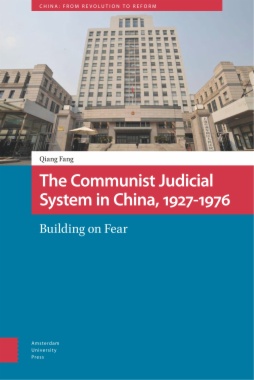Drawing on hundreds of newly released judicial archives and court cases, this book analyzes the communist judicial system in China from its founding period to the death of Mao Zedong. It argues that the communist judicial system was built when the CCP was engaged in a life-or-death struggle with the GMD, meaning that the overriding aim of the judicial system was, from the outset, to safeguard the Party against both internal and external adversaries. This fundamental insecurity and perennial fear of loss of power obsessed the Party throughout the era of Mao and beyond, prompting it to launch numerous political campaigns, which forced communist judicial cadres to choose between upholding basic legal norms and maintaining Party order. In doing all of this, The Communist Judicial System in China, 1927-1976: Building on Fear fills a major lacuna in our understanding of communist-era China.
- Cover
- Table of Contents
- Acknowledgement
- Acronyms
- Introduction
- Legal Hodgepodge
- The Judicial Pendulum
- Sources and Chapters
- 1 Born in Blood
- Theoretical Foundations of Communist Law
- The CCP’s Early Views of Law
- Overwhelming Threats of GMD Campaigns
- Early Judicial System in Soviet Bases
- Creating a Wartime Communist Judicial System
- The Communist Judicial System as Revealed in Cases
- Final Years of the Jiangxi Soviet Judicial System
- Born in Blood
- 2 Cornerstone or Aberration?
- War-Time Compromises of the CCP
- Rebuilding a Wartime Communist Judicial System
- Defending a Communist Judicial System
- A Comparison of GMD and CCP Criminal Laws
- Criminal Cases in the Border Area
- Civil Cases in the Border Area
- Legal Violations in the Border Area
- Legal Reform during the Second Civil War, 1945-1949
- Cornerstone or Aberration?
- 3 From “Excessive Lenience” to Harshness
- A Communist Court without Laws
- “Reviving” GMD Criminal Laws and Procedures
- Continued Leniency Toward Enemies
- Balance in Labor Disputes
- The Judicial System in an Anti-counterrevolutionary Campaign
- Harsher Penalties Amid the Campaign
- Conclusion
- 4 A Deliberate Purge
- Initiating the Legal Reform Movement
- Implementing the Legal Reform
- Fallout of Legal Reform
- New Cadres and Old Problems
- A Deliberate Purge
- Conclusion
- 5 A Golden Age?
- Constructing Legal Professionalism, 1954-July 1955
- The Judicial System in a Political Storm, June 1955-May 1956
- A Limited “Golden Age”? May 1956-May 1957
- A Short and Limited Golden Age
- 6 The Great Leap of Law
- The Anti-Rightist Movement and its Aftermath
- Rather “Left” than “Right”
- Court Decisions under the “Left”
- The Judicial System in the Great Leap
- The Great Leap of Law in Practice
- A Volatile Political Period, 1959-1965
- The Retreat from the Great Leap of Law, 1959-1962
- Legal Rehabilitation after 1962
- Conclusion
- 7 Not the Worst Period of Law
- Opening a Pandora’s Box
- The Judicial System in the Early Cultural Revolution, 1966-1967
- The Military Takeover of the Judicial System, 1968-1972
- Trials under Military Control
- The People’s Court Restored, 1972-1976
- Not the Worst Law Period
- Conclusion
- Conclusion
- Legalism and its Limitations
- Fear of Losing Power
- From Party’s Fear to People’s Fear
- Bibliography
- Primary Sources
- Secondary Sources
- Index
- List of Tables
- Table 2.1 Criminal cases in the border area (1938-1943)52
- Table 4.1 “Purged, recruited, and current cadres during national legal reform”
- Table 4.2 National judicial cadres before legal reform47
- Table 4.3 National judicial cadres’ conditions before and after legal reform48
- Table 4.4 Current judicial cadres in Central China provinces and cities67
- Table 6.1 No. of criminal cases in Guangdong province, 1949-1965
- Table 6.2 No. of criminal cases in Shaanxi province, 1950-1965
- Table 7.1 First-instance criminal cases in Shaanxi province, 1950-1978104
- Table 7.2 First-instance counterrevolutionary cases in Hunan province, 1950-1978105
- Table 7.3 First-instance criminal cases in Shanxi province, 1949-1978109

